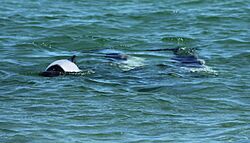Saunders Island, Falkland Islands facts for kids
Quick facts for kids
Saunders Island
Isla Trinidad
|
|
|---|---|
 |
|
| Country | Falkland Islands |
| Named for | Spanish: Trinity Island |
| Main settlement | Saunders Island Settlement |
| Area | |
| • Total | 131.6 km2 (50.8 sq mi) |
| Area rank | 4th |
| Highest elevation | 457 m (1,499 ft) |
| Time zone | UTC+3 (FKST) |
Saunders Island is a large island in the Falkland Islands, located northwest of West Falkland. It is the fourth largest island in the Falklands. Today, it is mainly used as a sheep farm.
The island covers about 131.6 square kilometers (50.8 square miles). Its coastline stretches for about 106.8 kilometers (66.4 miles). Saunders Island is roughly 21 kilometers (13 miles) long from east to west. It has three peninsulas, which are pieces of land almost surrounded by water. These peninsulas are connected by narrow strips of land. The island also has three large hilly areas. The highest point is Mount Richards, which is 457 meters (1,499 feet) tall.
Contents
A Look Back: Saunders Island History
Port Egmont on Saunders Island was the very first British settlement in the Falkland Islands. It was set up in 1765.
In January 1765, British Captain John Byron explored Saunders Island. He didn't know that the French had already settled at Port Louis on another island. Captain Byron claimed Saunders Island and its harbor, Port Egmont, for King George III. A British settlement was built at Port Egmont in 1766.
Also in 1766, Spain bought the French colony in the Falklands. By 1767, Spain was in charge of the islands. They placed the islands under a governor who reported to Buenos Aires.
The Falkland Crisis of 1770
In 1770, five Spanish warships entered Port Egmont. The small British force there had to give up. This event almost led to a war between Britain and Spain. However, in 1771, Spain agreed to give Port Egmont back to the British.
In 1776, the British left Port Egmont for money reasons. Before they left, they put up a special plaque. This plaque declared that the British still owned the Falkland Islands.
Saunders Island Today
The main settlement on the island now is called Saunders Island Settlement. It is located on the east coast and has its own airstrip.
There is a special old building here called the Stone House. It is a listed building, meaning it's important to history. For tourists, there are also modern buildings outside the main settlement. These buildings have heating, electricity, and running water. One building at a place called The Neck can host eight guests. Another building, called the Rookery Inn, can host four guests. The Pole-Evans family currently owns the island and runs the farm at the Settlement.
Protecting Nature: Conservation Efforts

There are several things people are doing to protect the nature on Saunders Island. One concern is the danger of fires. Some areas near the coast are also prone to erosion, which means the land wears away.
Another issue is overgrazing by animals. There are also animals that were brought to the island by accident, like wild cats, mice, rats, and rabbits. It's hard to remove these animals because the island is so big and has different types of land. A plant called spear thistle was also accidentally brought to the island and causes problems. Volunteers from Falklands Conservation are working to control this plant. They hope to get rid of it completely one day.
Amazing Wildlife
Saunders Island is home to some incredible wildlife. A small group of southern elephant seals breeds at Elephant Point. A few southern right whales also visit the bays to rest or find food.
Important Bird Area
BirdLife International has named Saunders Island an Important Bird Area (IBA). This means it's a very important place for birds. Many different bird species live and breed here.
Some of the important birds on the island include:
- Falkland steamer ducks (about 250 breeding pairs)
- Ruddy-headed geese
- King penguins
- Gentoo penguins (about 6,700 pairs)
- Southern rockhopper penguins (about 6,900 pairs)
- Macaroni penguins (about 4,200 pairs)
- Black-browed albatrosses (about 11,000 pairs)
- White-bridled finches
The island is also near the southernmost place where Magellanic penguins live. Gentoo penguins, however, live much further south, even in Antarctica. The island is also home to striated caracaras, which are birds of prey. These birds often stay close to the large seabird colonies during the summer. In 1995, members of the Royal Air Force Ornithological Society completed a full survey of the island's coast.
See also
In Spanish: Isla Trinidad (Malvinas) para niños



